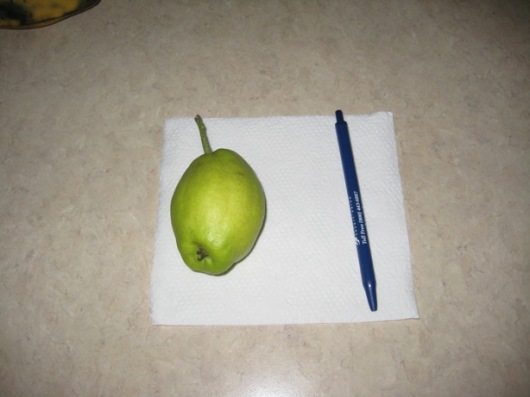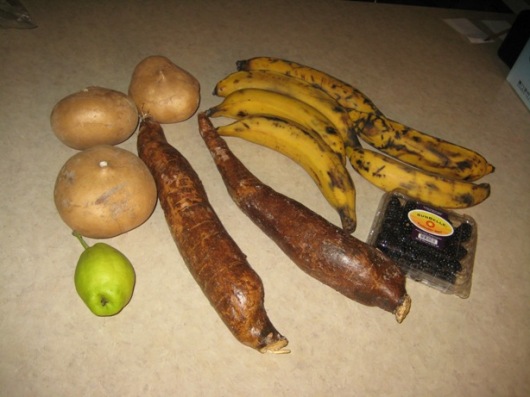Being middle-aged, it’s not every day I get to try a new variety of produce. Here on this blog, I’ve talked about some of the more exotic items that Leive & I enjoy: muscadine grapes, calamondins, Florida strawberries, bo’ongon (pumelo), and so on. Now we’re adding Korla pears to the list.
Back when we lived in Orlando, we visited the Asian grocery stores from time to time, to get special ingredients for Leive’s cooking that you can’t find in a Winn Dixie or Publix. Usually that meant a trip to the Vietnamese stores clustered around the intersection of Mills Ave. and Colonial Dr., a neighborhood that has earned the nickname “Little Saigon.” I also remember a couple of Korean stores and a Thai store scattered around the city, but we never got excited about them. Then when a Filipino store, M & M Philippine Mart, opened on East Colonial Dr., we usually went to that, and I only visited the Vietnamese stores when M & M didn’t have what we were looking for. Filipinos don’t seem to be born shopkeepers, the way the Vietnamese and Koreans are, but understandably Leive wanted to help out her own nationality. Or as I put it, “We have to support the home team!”
Here in Kentucky, the choices are more limited. The nearest Filipino store that we know of is Lanceta Trading, in Louisville. For Lexington itself, we currently have three choices: Seoul Supermarket on New Circle Rd., Yu-Yu near the University of Kentucky, and Dong Yang on Clays Mill Rd. There used to be two others, but they closed after we arrived in town. Finally, there are two Indian stores, both named Sagar Market, which are worth visiting if you want spices or rice; one of them is only a mile from my house.
Of the three Far Eastern places, Seoul Supermarket is the closest, and usually the cheapest. Dong Yang is the hardest to find, because they don’t even have an English sign on the door, but once or twice I’ve found something there that the other stores didn’t stock. Yu-Yu is the youngest, having opened in January 2007, and definitely the largest. In a rough comparison of Lexington and Orlando stores, I’d say that Yu-Yu most resembles Orlando’s Tien Hung, in size and variety, except that Yu-Yu doesn’t have a jewelry section. And I have not yet found an Asian store in Kentucky that’s as big as Dong A and Phuoc Loc Tho in Orlando.
Anyway, we headed to Yu-Yu yesterday afternoon to stock up on supplies, because the international banquet at our church is only two weeks away. She also wanted to get an herb we found on our last visit. Because we don’t know the proper name for it (a lot of the produce in Yu-Yu comes in unmarked boxes), and it looks like bundles of long grass, we just call it “weeds.” While looking among the fruits and veggies, I spotted a box of small green pears, and the label on the box said it came from Korla, Xinjiang, China. That got my attention, because Xinjiang (also called Sinkiang, Chinese Turkestan, or Uyguristan), is so far from the nearest ocean that I consider it part of Central Asia, rather than part of China. I don’t expect to see groceries from a place that remote; maybe now I should keep an eye out for melons from Uzbekistan.
At $2.33 a pound, those pears were expensive; no surprise there. To try them out, I selected four of them, and Leive filled the shopping cart with other stuff. At home, as soon as we got the groceries inside, Leive tried a pear, and told me it was superb. I have had many pears over the years — Bartlett, Bosc, Anjou, Red Comice, Seckel, Asian, Yali, and Royal Riviera pears, so let me try to describe the Korla variety. It doesn’t look impressive, being only the size of an egg. You have the typical pear shape, and it’s a darker green color than I’ve seen in other pears, even the Anjou. Not much of a taste, either. However, there’s more juice than you’d expect from a fruit that small; that’s what Leive liked best. Also, there’s a faint but noticeable fragrance, sort of like the smell of an open spice cabinet. Definitely unique. Before midnight, we had finished all four of them.
I did a Google search, and most of the pages I found about Korla pears either discussed the company that ships them, or the years of negotiations that it took to make it legal to export pears to the United States. The only page that talked about the pears themselves was this bad translation. If it can be trusted, the extremes of temperature and rainfall in that region are what make the pears tasty & fragrant, so I should forget about growing them here, even though other pears seem to like Kentucky’s climate. I also looked up Korla in Wikipedia, and found out it’s a city of 430,000 people, on the northern edge of the Tarim Basin. The population is more than half ethnic Chinese, with Uyghurs, Mongols and Huis making up the rest. Well, China’s the only country (except maybe for India), where you can have a city that big, and most of the rest of the world doesn’t even notice it!
Here’s a picture I took of the last pear, with a napkin and ballpoint pen for size comparison:

And Leive wanted you to see a few other things we got at the store. Besides the pear, here are three jicamas, two yuca roots (the main ingredient for cassava cake), six banana plantains, and a container of blackberries.

Last August 7, 2008, I wrote that pears are native to Central Asia. Now I’m wondering if the original variety of pear looked and tasted much like the ones we tried yesterday.